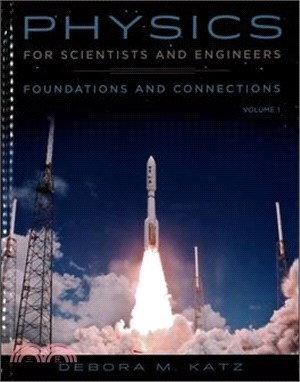商品簡介
Cengage Learning is pleased to announce the publication of Debora Katz’s ground-breaking calculus-based physics program, PHYSICS FOR SCIENTISTS AND ENGINEERS: FOUNDATIONS AND CONNECTIONS. The author’s one-of-a-kind case study approach enables students to connect mathematical formalism and physics concepts in a modern, interactive way. By leveraging physics education research (PER) best practices and her extensive classroom experience, Debora Katz addresses the areas students struggle with the most: linking physics to the real world, overcoming common preconceptions, and connecting the concept being taught with the mathematical steps to follow.
How Dr. Katz deals with these challenges—with case studies, student dialogues, and detailed two-column examples—distinguishes this text from any other on the market and will assist you in taking your students “beyond the quantitative.”
Features
Case studies, many based on real-world experiences such as news items and historical events, draw readers into the story of physics and make concepts understandable. The case studies are introduced and revisited throughout the chapters in interactive concept exercises, examples, and end-of-chapter problems. This unique case study approach makes abstract physics concepts concrete and bridges the formal language and mathematics of physics with key concepts.
Dr. Katz uses student preconceptions (or misconceptions) as building blocks toward proper understanding, showing students the connection between their notions and the true physical principles. Preconceptions are primarily addressed by dialogues between fictional students that allow readers to discover their preconceptions without a sense of failure.
Two-column examples and derivations use graphics to clearly frame the qualitative reasoning and quantitative steps behind a problem, helping students make connections between the concept being taught and the mathematical steps to follow. It’s like having an instructor in the text: in one column he or she explains the concept, and in the other he or she shows the formal mathematical steps that might be written on a classroom board.
Many textbooks were originally written for previous generations of students. Although these textbooks have been updated for content, today’s students don’t find them readable. This book was written to be readable without compromising content, because students are willing and able to read a book they find engaging.
Students have trouble organizing physics topics in a hierarchy. The list of topics at the start of each chapter is arranged into categories: Underlying Principles, Major Concepts, Special Cases, and Tools. Notes in the margin refer to topics using these categories. Each chapter has a Summary at the end arranged using the same categories. The conceptual organization is reinforced by revisiting the concepts found on the chapter opening page with more complete descriptions, so students can use the information for review before solving the problems assigned for homework.
Over 3,500 problems have been written for this text. Each part of every problem has been classified as either Algebraic, Conceptual, Estimation, Graphical, or Numerical in nature.
This text is fully integrated with Enhanced WebAssign. Enhanced WebAssign combines exceptional physics content with the most powerful online homework solution, WebAssign. Enhanced WebAssign engages students with simulation-based PreLecture Exploration exercises, Integrated Tutorials written by the author, stepped out interactive solutions, all the quantitative End-of-Chapter problems from the textbook, and a fully customizable eBook. This robust suite of assets will help students develop a deeper conceptual understanding of their subject matter. Please visit http://www.webassign.net/features/textbooks/katzpse1/details.html to view an interactive demonstration of Enhanced WebAssign.
目次
Part I: CLASSICAL MECHANICS.
1. Getting Started.
2. One-Dimensional Motion.
3. Vectors.
4. Two- and Three-Dimensional Motion.
5. Newton’s Laws of Motion.
6. Applications of Newton’s Laws of Motion.
7. Gravity.
8. Conservation of Energy.
9. Energy in Non-Isolated Systems.
10. Systems of Particles and Conservation of Momentum.
11. Collisions.
12. Rotation I: Kinematics and Dynamics.
13. Rotation II: A Conservation Approach.
Part II: MECHANICS OF COMPLEX SYSTEMS.
14. Static Equilibrium, Elasticity, and Fracture.
15. Fluids.
16. Oscillations.
17. Traveling Waves.
18. Superposition and Standing Waves.
19. Temperature, Thermal Expansion, and Gas Laws.
20. Kinetic Theory of Gases.
21. Heat and the First Law of Thermodynamics.
22. Entropy and the Second Law of Thermodynamics.
Appendix A. Mathematics.
Appendix B. Reference Tables.
Periodic Table of the Elements.
Answers to Concept Exercises and Odd-Numbered Problems.
Index.
主題書展
更多書展本週66折
您曾經瀏覽過的商品
購物須知
為了保護您的權益,「三民網路書店」提供會員七日商品鑑賞期(收到商品為起始日)。
若要辦理退貨,請在商品鑑賞期內寄回,且商品必須是全新狀態與完整包裝(商品、附件、發票、隨貨贈品等)否則恕不接受退貨。
























